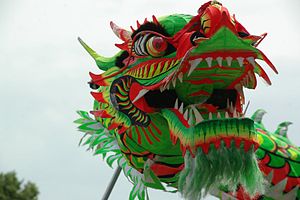Dragon dance
| Dragon dance | |||||||
 |
|||||||
| Traditional Chinese | |||||||
|---|---|---|---|---|---|---|---|
| Simplified Chinese | |||||||
|
|||||||
| Alternative Chinese name | |||||||
| Traditional Chinese | |||||||
|
|||||||
| Transcriptions | |
|---|---|
| Standard Mandarin | |
| Hanyu Pinyin | wǔ lóng |
| Transcriptions | |
|---|---|
| Southern Min | |
| Hokkien POJ | lāng-liông or lāng-lêng |
Dragon dance (simplified Chinese: ; traditional Chinese: ; pinyin: wǔ lóng) is a form of traditional dance and performance in Chinese culture. Like the lion dance it is most often seen in festive celebrations. The dance is performed by a team of dancers who manipulate a long flexible figure of a dragon using poles positioned at regular intervals along the length of the dragon. The dance team simulates the imagined movements of this river spirit in a sinuous, undulating manner.
The dragon dance is often performed during Chinese New Year. Chinese dragons are a symbol of China, and they are believed to bring good luck to people, therefore the longer the dragon in the dance, the more luck it will bring to the community. The dragons are believed to possess qualities that include great power, dignity, fertility, wisdom and auspiciousness. The appearance of a dragon is both fearsome and bold but it has a benevolent disposition, and it was an emblem to represent imperial authority. The movements in a performance traditionally symbolize historical roles of dragons demonstrating power and dignity.
During the Han Dynasty, different forms of the dragon dance were described in ancient texts. Rain dance performed at times of drought may involve the use of figures of dragon as Chinese dragon was associated with rain in ancient China, for example the dragon Yinglong was considered a rain deity, and the Shenlong had the power to determine how much wind and rain to bring. According to the Han Dynasty text Luxuriant Dew of the Spring and Autumn Annals by Dong Zhongshu, as part of a ritual to appeal for rain, clay figures of the dragons were made and children or adults may then perform a dance. The number of dragons, their length and colour, as well as the performers may vary according to the time of year. Other dances involving dragons may be found in a popular form of entertainment during the Han Dynasty, the baixi (百戲) variety shows, where performers called "mime people" (象人) dressed up as various creatures such as beasts, fish and dragons. In his Lyric Essay on Western Capital (西京賦) Zhang Heng recorded various performances such as performers who dressed as a green dragon playing a flute, and a fish-dragon act where fish transformed into a dragon. A version of the fish-dragon dance called "fish-dragon extending" (魚龍曼延) was also performed at the Han court to entertain foreign guests – in this dance a mythical beast of Shenli (舍利之獸) transforms into flounder, then to a dragon. These ancient dances however do not resemble modern Dragon Dance in their descriptions, and depictions of dragon dance in Han Dynasty stone relief engravings suggest that the props used may also be cumbersome, unlike modern Dragon Dance where light-weight dragons are manipulated by performers.
...
Wikipedia
